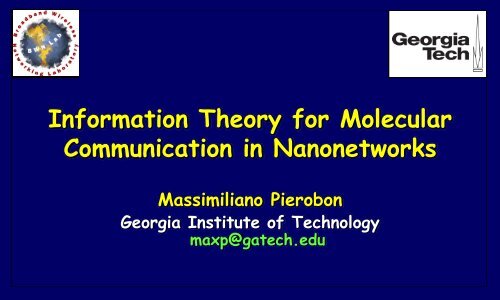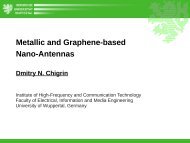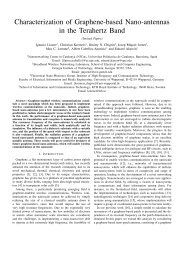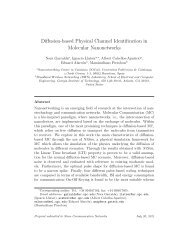Information Theory for Molecular Communication ... - N3Cat - UPC
Information Theory for Molecular Communication ... - N3Cat - UPC
Information Theory for Molecular Communication ... - N3Cat - UPC
Create successful ePaper yourself
Turn your PDF publications into a flip-book with our unique Google optimized e-Paper software.
<strong>In<strong>for</strong>mation</strong> <strong>Theory</strong> <strong>for</strong> <strong>Molecular</strong><br />
<strong>Communication</strong> in Nanonetworks<br />
Massimiliano Pierobon<br />
Georgia Institute of Technology<br />
maxp@gatech.edu
Towards an <strong>In<strong>for</strong>mation</strong> <strong>Theory</strong> <strong>for</strong><br />
<strong>Molecular</strong> <strong>Communication</strong><br />
• Physical Channel Model<br />
• How in<strong>for</strong>mation is transmitted, propagated and received<br />
when a molecular carrier is used<br />
• Noise Representation<br />
• How can be physically and mathematically expressed the<br />
noise affecting in<strong>for</strong>mation transmitted through molecular<br />
communication<br />
• <strong>In<strong>for</strong>mation</strong> Encoding/Decoding<br />
• How can in<strong>for</strong>mation be encoded <strong>for</strong> a proper transmission<br />
using molecular communication<br />
<strong>Molecular</strong><br />
Channel<br />
Capacity<br />
JMJM MP<br />
GaTech - <strong>UPC</strong><br />
2
Physical Channel Model: Molecule Diffusion<br />
M. Pierobon, and I. F. Akyildiz, ``A Physical Channel Model<br />
<strong>for</strong> <strong>Molecular</strong> <strong>Communication</strong> in Nanonetworks,’’<br />
submitted <strong>for</strong> journal publication, March 2009.<br />
• Molecule Diffusion <strong>Communication</strong>: Exchange of in<strong>for</strong>mation encoded<br />
in the concentration variations of molecules.<br />
TN<br />
RN<br />
JMJM MP<br />
Emission<br />
process<br />
Diffusion<br />
process<br />
GaTech - <strong>UPC</strong><br />
Reception<br />
process<br />
3
Objective of the Physical Channel Model<br />
M. Pierobon, and I. F. Akyildiz, ``A Physical Channel Model <strong>for</strong><br />
<strong>Molecular</strong> <strong>Communication</strong> in Nanonetworks,’’<br />
submitted <strong>for</strong> journal publication, March 2009.<br />
Derivation of DELAY and ATTENUATION<br />
as functions of the frequency and the transmission range<br />
• Non-linear attenuation with respect to the frequency<br />
• Distortion due to delay dispersion<br />
JMJM MP<br />
GaTech - <strong>UPC</strong><br />
4
Modeling Challenges <strong>for</strong> the Physical Channel<br />
M. Pierobon, and I. F. Akyildiz, ``A Physical Channel Model <strong>for</strong> <strong>Molecular</strong><br />
<strong>Communication</strong> in Nanonetworks,’’<br />
submitted <strong>for</strong> journal publication, March 2009.<br />
• Transmitter<br />
• How chemical reactions allow the modulation of molecule concentrations as<br />
transmission signals<br />
• Propagation<br />
• How the “particle diffusion” controls the propagation of modulated<br />
concentrations<br />
• Receiver<br />
• How chemical reactions allow to sense the modulated molecule concentrations<br />
from the environment and translate them into received signals<br />
JMJM MP<br />
GaTech - <strong>UPC</strong><br />
5
Molecule Diffusion Channel Model<br />
M. Pierobon, and I. F. Akyildiz, ``A Physical Channel Model<br />
<strong>for</strong> <strong>Molecular</strong> <strong>Communication</strong> in Nanonetworks,’’<br />
submitted <strong>for</strong> journal publication, March 2009.<br />
Transmitter Model<br />
• Design of a chemical actuator scheme (chemical<br />
transmitting antenna)<br />
• Analytical modeling of the chemical reactions involved in<br />
an actuator<br />
• Signal to be transmitted Modulated concentration<br />
JMJM MP<br />
GaTech - <strong>UPC</strong> 6
Molecule Diffusion Channel Model<br />
M. Pierobon, and I. F. Akyildiz, ``A Physical Channel Model<br />
<strong>for</strong> <strong>Molecular</strong> <strong>Communication</strong> in Nanonetworks,’’<br />
submitted <strong>for</strong> journal publication, March 2009.<br />
Propagation Model<br />
• Solution of the diffusion physical laws (FICK’s First and Second<br />
Laws (1855), Relativistic Diffusion Process) in the presence of an<br />
external concentration modulation<br />
• Modulated concentration Space-time concentration evolution<br />
JMJM MP<br />
GaTech - <strong>UPC</strong> 7
Molecule Diffusion Channel Model<br />
M. Pierobon, and I. F. Akyildiz, ``A Physical Channel Model<br />
<strong>for</strong> <strong>Molecular</strong> <strong>Communication</strong> in Nanonetworks,’’<br />
submitted <strong>for</strong> journal publication, March 2009.<br />
Receiver Model<br />
• Design of a chemical receptor scheme (chemical receiving antenna)<br />
• Analytical modeling of the chemical reactions involved in a<br />
receptor<br />
• Propagated modulated concentration Received signal<br />
JMJM MP<br />
GaTech - <strong>UPC</strong> 8
Conclusions<br />
M. Pierobon, and I. F. Akyildiz, ``A Physical Channel Model<br />
<strong>for</strong> <strong>Molecular</strong> <strong>Communication</strong> in Nanonetworks,’’<br />
submitted <strong>for</strong> journal publication, March 2009.<br />
• A mathematical model <strong>for</strong> the physical molecular<br />
diffusion channel<br />
• Non-linear channel attenuation both in frequency<br />
and Tx-Rx range<br />
• Channel Tx-Rx delay varies in frequency <br />
dispersion phenomena when the signal propagates<br />
JMJM MP<br />
GaTech - <strong>UPC</strong> 9
Current Research<br />
• Noise incorporated into the channel model<br />
• Study of possible noise sources:<br />
• When in<strong>for</strong>mation modulates the molecule concentration<br />
• When in<strong>for</strong>mation is encoded into molecule chemical<br />
features (e.g., type, structure, polarization, etc.)<br />
JMJM MP<br />
GaTech - <strong>UPC</strong> 10
Noise Representation<br />
Molecule concentration modulation<br />
Nano<br />
mac<br />
1<br />
Diffusion Process<br />
Chemical change<br />
Brownian motion<br />
Nano<br />
mac<br />
3<br />
Nano<br />
mac<br />
2<br />
<strong>In<strong>for</strong>mation</strong> mixing<br />
Turbulence<br />
same molecule as<br />
JMJM MP<br />
GaTech - <strong>UPC</strong> 11
Noise Representation<br />
Molecule chemical feature encoding<br />
Nano<br />
mac<br />
1<br />
Extinction latency<br />
Cross-symbol<br />
interference<br />
Symbol<br />
Info<br />
0110<br />
0111<br />
Nano<br />
mac<br />
3<br />
Nano<br />
mac<br />
2<br />
Symbol usage<br />
desynchronizing<br />
JMJM MP<br />
GaTech - <strong>UPC</strong> 12
<strong>In<strong>for</strong>mation</strong> Encoding/Decoding<br />
• Concentration Modulation (e.g. Ca 2+ ion signaling)<br />
• <strong>In<strong>for</strong>mation</strong> Encoding Based on Chemical Features<br />
(e.g. pheromone communication)<br />
• Encapsulation of <strong>In<strong>for</strong>mation</strong> Carriers (e.g. DNA<br />
vesicle encapsulation, pollen/spores communication)<br />
JMJM MP<br />
GaTech - <strong>UPC</strong> 13
Future Research and Challenges<br />
• Properly model all the noise sources<br />
• <strong>In<strong>for</strong>mation</strong> encoding/decoding and modulation pattern<br />
• Channel Capacity computation<br />
• Channel multiple access problem<br />
• Addressing issue (routing problem)<br />
• Higher layers development<br />
JMJM MP<br />
GaTech - <strong>UPC</strong> 14
Thanks <strong>for</strong><br />
your attention<br />
“<strong>In<strong>for</strong>mation</strong> <strong>Theory</strong> <strong>for</strong> <strong>Molecular</strong><br />
<strong>Communication</strong> in Nanonetworks”<br />
Massimiliano Pierobon<br />
JMJM MP<br />
GaTech - <strong>UPC</strong> 15







